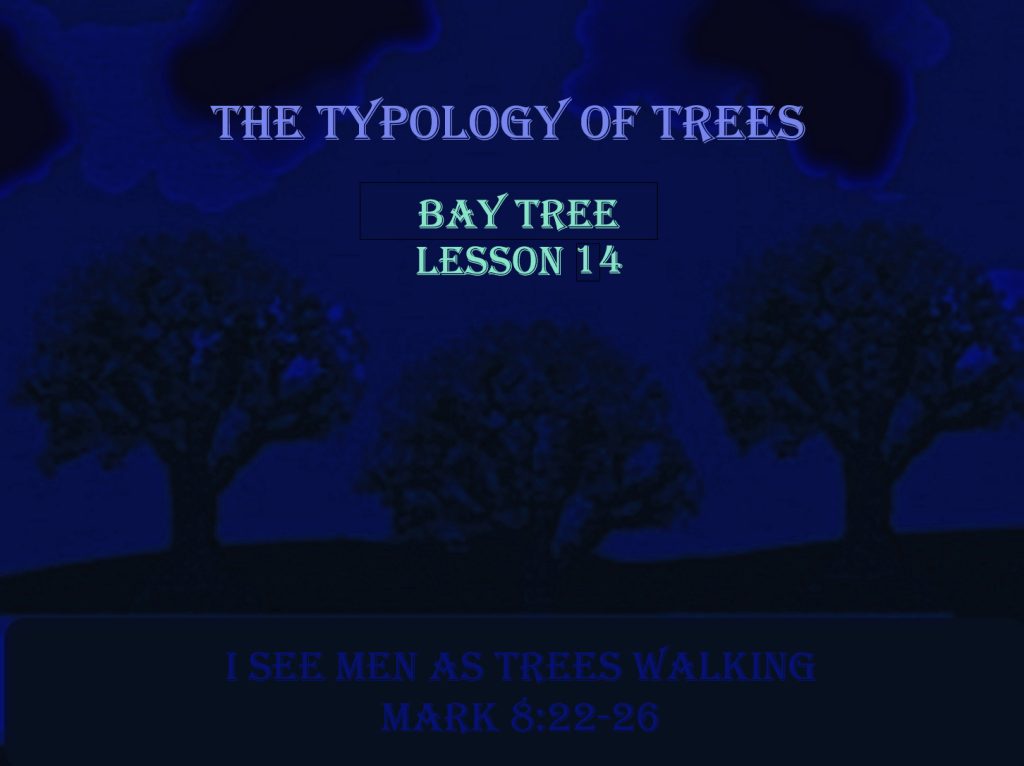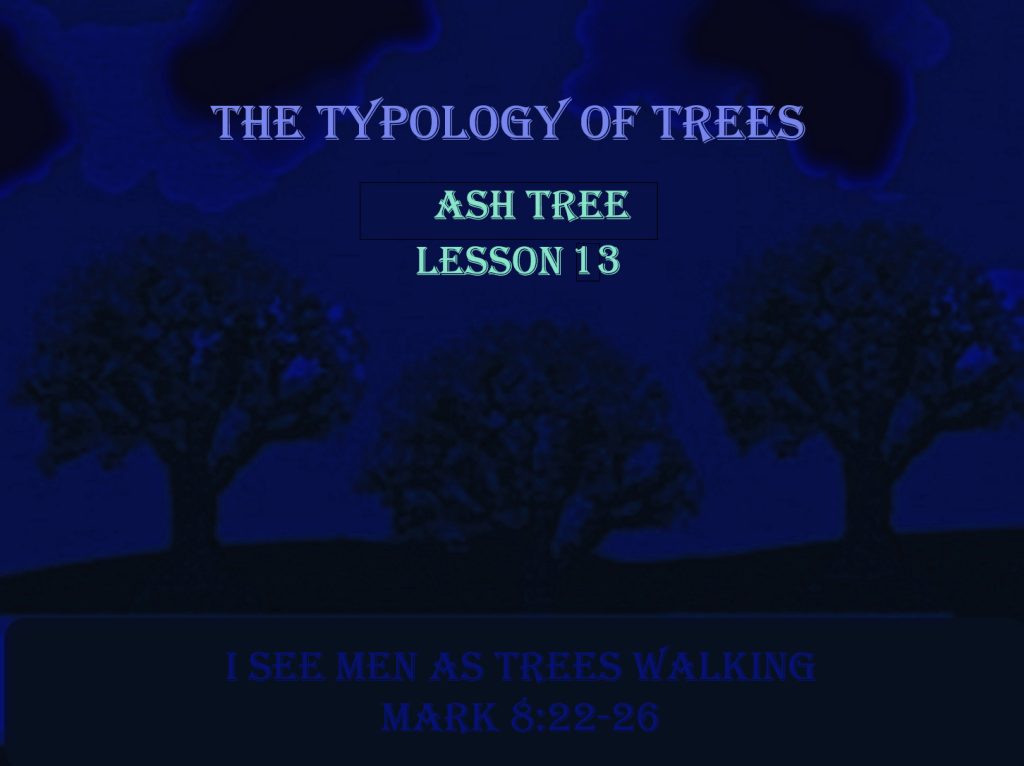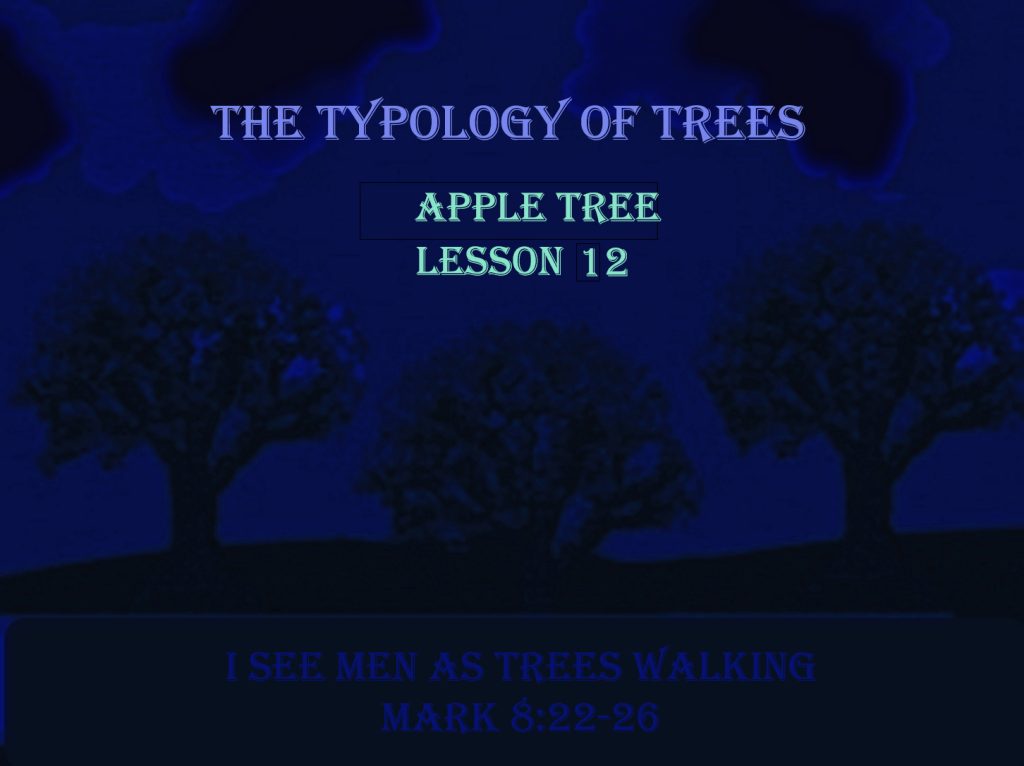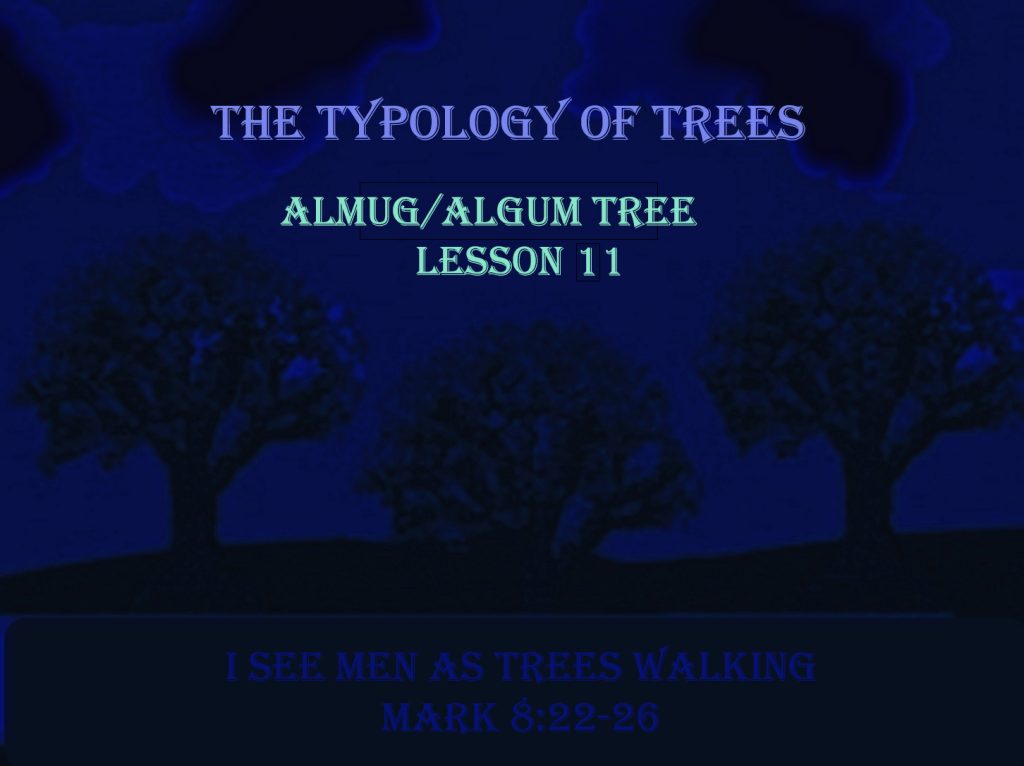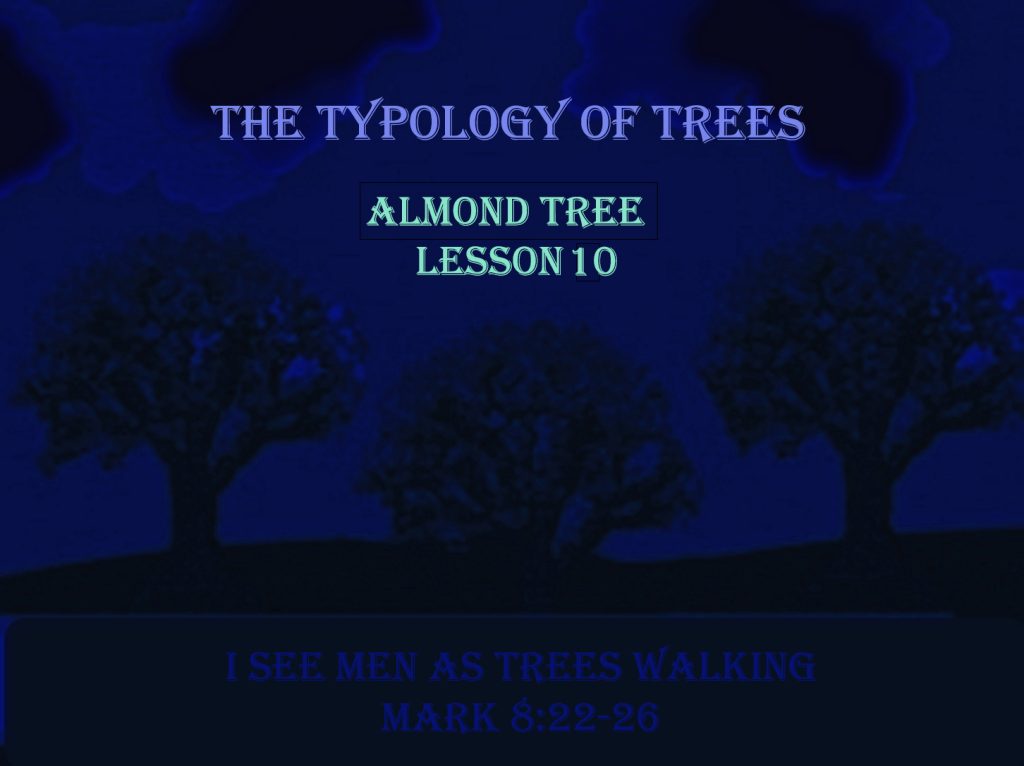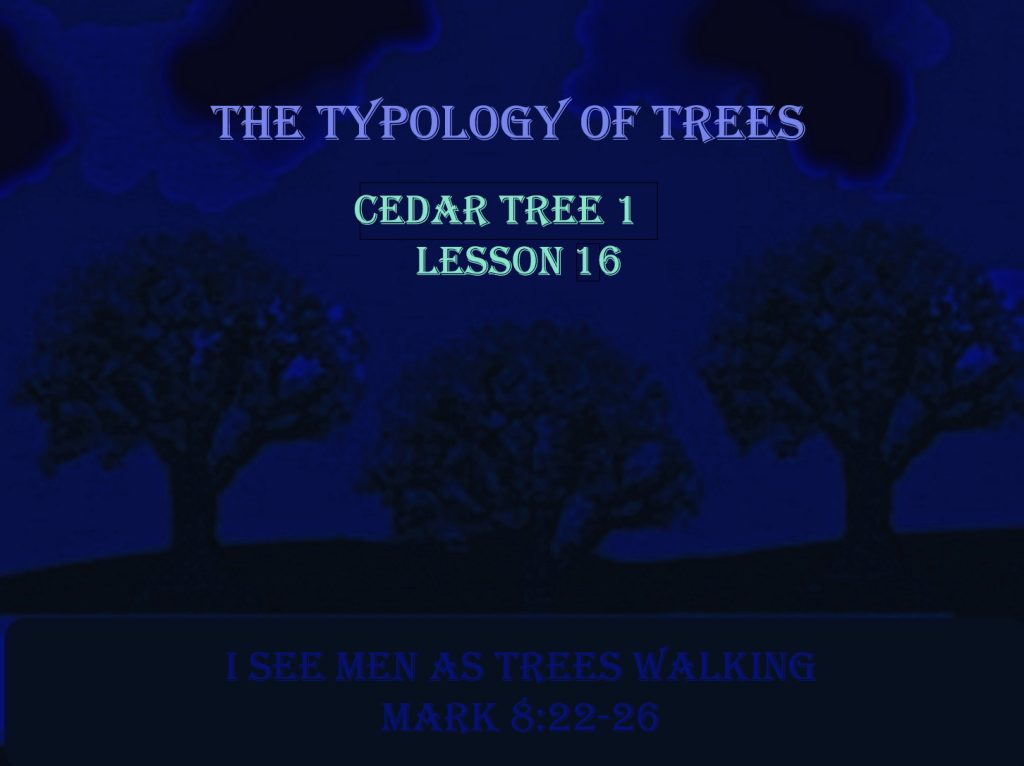
(TY200 – Lesson 16)
By Kathy L McFarland
7/25/2024
The Mysteries of Trees
Mark 8:22–26 (KJV 1900)
22 And he cometh to Bethsaida; and they bring a blind man unto him, and besought him to touch him. 23 And he took the blind man by the hand, and led him out of the town; and when he had spit on his eyes, and put his hands upon him, he asked him if he saw ought. 24 And he looked up, and said, I see men as trees, walking. 25 After that he put his hands again upon his eyes, and made him look up: and he was restored, and saw every man clearly. 26 And he sent him away to his house, saying, Neither go into the town, nor tell it to any in the town.
TY200 – INTERPRETATION CONFIDENCE CHART
- Typology known as fully God’s Truth concerning trees walking as recorded in Mark 8:22-26 (Those specifically, typologically identified in Scripture)
- Trees in Scripture identify the different Spiritual Lives that are lived on this Earth
- Different parts of the trees walking with Christ are fully represented in Scripture as God’s Truth
- Tree – Spiritual Lives of forgiven followers walking with the Lord Jesus Christ and producing powerful fruits of His.
- Root – The foundation of a tree from firstfruit that is secured by a lump of clay that can grow and produce living works of fruit
- Leaves – The preparation that LORD God makes for the coming events of living works.
- Fruit – Living works of the LORD God, done through followers (Branch) of the Lord Jesus Christ (Vine) at the guidance of the Holy Spirit with the spiritual life of a walking tree.
- Seed – Word of God.
- The fruit of righteousness is a Tree of Life.
- Cedar Tree – Spiritual life defines politically, worldly, and socially powerful leaders with spiritual hints of (righteous or wicked) strength whose height is far beyond regular people. They are the political superstars with religious overtones throughout their persona. They can start their growth as righteous or secular; but eventually take on spiritual overtones and end up wicked. When one man assumes that great of power, then the spiritual side with the LORD God and the Lord Jesus Christ and their Holy Spirit is denied eventually. To gain such great power over people requires astute political manipulative control over their world with hints of divine empowerment; most often, that powerful of a man or woman leader realizes the need for appearances that “God is on their side,” whether it be for war or rule or privilege. So just as Lucifer dipped his roots into the biggest “flowing grace of God” river so do those that want to be ultimate ruler. It means nothing if their soul is measured. But it means everything to trick the masses and gain the power necessary to rule the world.
- a. Righteous Cedar Tree – The Spiritual Life that is beautiful, politically, and socially powerful, more spiritual growth than all the other trees, many protected followers. Can be goodly and righteous; but risks becoming a tyrant with a very thin line dividing righteousness from wickedness. They must have the shittah, myrtle, and oil trees surrounding them so they can see, know, consider, and understand, to maintain their righteous state.
- b. Unrighteous Cedar Tree – The Spiritual Life of a tyrant. He lifts himself in height, he shoots up his top among the thick boughs, and his heart lifts in his height. He is all-powerful but wicked, with no Christian support surrounding him.
- Typology Known Confidently (Those represented in Scripture with enough frequency, sufficiency, and accuracy to reveal their typological meanings with full Truth of God unchallenged and supported by the Holy Spirit’s teachings)
- Almond Tree – The believer, as an almond tree, is a Christian leader, chosen by God, that watches over the works of Christians guided by the Lord, and the people he serves.
- Algum/Almug Tree – The Spiritual Life works that honors the LORD God and guides Believers to come closer to Him toward the beauty of His Holiness through the Lord Jesus Christ. Musical worship and high praise are often expressed through these types of Christian works.
- Apple Tree – A Spiritual Life that can comfort those that love God, regardless of their status of sin. These Spiritual works provide protection, sweetness of life; the Christians doing these works are often beloved amongst the worldly receivers. (Believers from the Salvation Army, Catholic Charities, Lutheran, Baptist, and Methodist Social Services, and other Missionary and denominational efforts to house the homeless, feed the hungry, and provide comfort in despair are excellent examples of this type of spiritual lives lived in duty toward their works for God.)
- Ash Tree – A Spiritual Life with a deceived heart, that stands among places of Christians and worships different false gods created by other human beings or self.
- Typology Known Probably (Knowledge of Scripture, God’s Way, Logic and common sense in the typological meaning can NOT be confirmed fully with the Word of God and the moving of the Holy Spirit)
- Bay Tree – Native spiritual life that develops naturally.
- Fake Bay Tree – Imitation spiritual life forced upon believers through powerful coercion, trickery, evil, or control.
- Box Tree – Spiritual life that stands in the midst of dryness. The location the Box Tree stands is empty of both worldly people and the flowing grace of the LORD God. Here stands the lonely Christian as a beacon for the uncommon seeker of God. Eventually, the Box Tree is combined with the other beautiful spiritual life souls that serve in the world and in the dry places and perform ministry guided by the Holy Spirit and coming together in the Sanctuary of the Lord. A possible identity of a Box Tree is a missionary that serves in extreme conditions with few common people, the lack of Christian presence and the lack of the movements of God.
- Typology NOT Known (Can NOT make even simple assumptions of the typological meaning because there is NOT enough frequency, sufficiency, or accuracy recorded in Scripture, and the Holy Spirit is NOT teaching deeper meaning)
Teachings by Kathy L McFarland
We are going to start our study of the cedar tree with the most unrighteous cedar tree that ever was.
We can learn the greatest characteristics of a spiritual life represented by the cedar tree, and how that spiritual life can go so wrong when darkness and evil enter it. Because Ezekiel 31 is so vividly descriptive of the cedar tree gone bad, we get a rare insight into the typology of the cedar tree and can define it from just this chapter. Please keep your focus upon the characteristics of the tree.
Ezekiel 31:1–9 (KJV 1900)
And it came to pass in the eleventh year, in the third month, in the first day of the month, that the word of the Lord came unto me, saying, 2 Son of man, speak unto Pharaoh king of Egypt, and to his multitude; Whom art thou like in thy greatness? 3 Behold, the Assyrian was a cedar in Lebanon with fair branches, and with a shadowing shroud, and of an high stature; and his top was among the thick boughs. 4 The waters made him great, the deep set him up on high with her rivers running round about his plants, and sent out her little rivers unto all the trees of the field. 5 Therefore his height was exalted above all the trees of the field, and his boughs were multiplied, and his branches became long because of the multitude of waters, when he shot forth. 6 All the fowls of heaven made their nests in his boughs, and under his branches did all the beasts of the field bring forth their young, and under his shadow dwelt all great nations. 7 Thus was he fair in his greatness, in the length of his branches: for his root was by great waters. 8 The cedars in the garden of God could not hide him: the fir trees were not like his boughs, and the chesnut trees were not like his branches; nor any tree in the garden of God was like unto him in his beauty. 9 I have made him fair by the multitude of his branches: so that all the trees of Eden, that were in the garden of God, envied him.
1. The Word of God came to Ezekiel and instructed him to speak to the Pharaoh king of Egypt,[1]and to his people.
2. The LORD God wanted the Pharaoh to look upon His greatness and know that He had a high stature that was more than any other person on earth.
3. The Pharaoh was an Assyrian from Iraq but once dwelled in Lebanon.
4. The tallest and best cedars (excluding those in God’s Garden of Eden) were in the territory of Lebanon and are referenced numerous times in Scripture.
5. The spiritual identity of the Pharaoh had:
a. Beautiful branches
b. Shadowing shroud – 7511 III. צָלַ ל (ṣāꞏlǎl): v.; ≡ Str 6751; TWOT 1921—1. LN 14.53–14.62 (qal pf.) grow darker, i.e., have an increasing condition of darkness (Ne 13:19+); 2. LN 14.53–14.62 (hif ptcp.) give shade, i.e., cause a shadow by interposing something between an object and a light source (Eze 31:3+)[2]
c. High stature (high up in height)
d. Top was above thick boughs
6. The waters, spoken of during Creation, called the “deep” set him up on high. The actual Assyrian Pharaoh was not revealed to be alive during the time of creation. Thus, his spirit must be identified as another.
a. The “deep” in Eziekiel – 9333 תְּהוֹם (tehôm): n.fem. and masc.; ≡ Str 8415; TWOT 2495a— 1. LN 1.17–1.25 the deep, the depths, i.e., an area below the surface of bodies of water, a dark, inaccessible, inexhaustible, and mysterious place controlled only by objects with vast powers (Ge 1:2; 7:11; 8:2; 49:25; Ex 15:5, 8; Dt 33:13; Job 28:14; 38:16, 30; 41:24[EB 32]; Ps 33:7; 36:7[EB 6]; 42:8[EB 7]; 77:17[EB 16]; 78:15; 104:6; 106:9; 107:26; 135:6; 148:7; Pr 3:20; 8:24, 27, 28; Isa 51:10; 63:13; Eze 26:19; Am 7:4; Jnh 2:6[EB 5]; Hab 3:10+), see also domain LN 81.3–81.11; 2. LN 1.69–1.78 deep springs, i.e., a body of water which comes out of the earth (Dt 8:7; Eze 31:4, 15+); 3. LN 1.17–1.25 unit: תְּהוֹם הַ־ אֶרֶ ץ (tehôm hǎ– ʾěꞏrěṣ) Sheol, formally, depths of the earth, i.e., the place where the dead reside (Ps 71:20+)[3]
b. The “deep” in Genesis:
Genesis 1:1–2 (KJV 1900)
In the beginning God created the heaven and the earth. 2 And the earth was without form, and void; and darkness was upon the face of the deep. And the Spirit of God moved upon the face of the waters.
i. Darkness – 3125 חֹשֶׁ (ḥōꞏšěḵ): n.masc.; ≡ Str 2822; TWOT 769a—1. LN 14.53– 14.62 darkness, the dark, i.e., the lack of light in a space (Ge 1:4; Ex 10:21); Note: there are many associative meanings to “darkness,” including terror, ignorance, sadness, confusion, evil [4]
ii. Genesis 1:3–5 (KJV 1900)
3 And God said, Let there be light: and there was light. 4 And God saw the light, that it was good: and God divided the light from the darkness. 5 And God called the light Day, and the darkness he called Night. And the evening and the morning were the first day.
c. Big Rivers ran around the greatest cedar’s plants
i. His height was exalted above all the trees of the field
ii. His boughs were multiplied
iii. His branches became long
iv. He shot forth
d. Little rivers ran around the trees of the fields (fields = world)
e. The greatest cedars height grew above the trees of the fields because it received more water from the big river
i. All the fowls of Heaven (angels) made their nests in His boughs
ii. Under his branches did all the beasts of the field (carnal people) bring forth their young
iii. Under his shadow dwelt all great nations (he is politically strong)
f. He was beautiful in his greatness
i. Because of the length of his branches
ii. Because his root was by great waters
g. The cedars in the Garden of the LORD God could not hide him
i. Thus, we can reason that the LORD God planted cedars in the Garden of Eden
ii. We can reason that this gigantic, beautiful cedar tree was larger than the largest cedars planted in the Garden of Eden
iii. We can reason that this tree stood shadowed all other cedar trees
1. Hidden – 6669 I. עָמַ ם (ʿāꞏmǎm): v.; ≡ Str 6004; TWOT 1641—LN 64 (qal) be rival to, be equal to, i.e., be in a comparable state of something, and so be like something or someone else (Eze 28:3; 31:8+), note: for another interp in 28:3, see 6670[5]
2. Hidden – 6670 II. עָמַ ם (ʿāꞏmǎm): v.; ≡ Str 6004; TWOT 1641—1. LN 28.68–28.83 (qal pf.) be hidden, i.e., be in a state in which something cannot be known and so be secret (Eze 28:3+), note: for another interp, see 6669; 2. LN 14.36–14.52 (hof impf.) lose luster, be dimmed, i.e., pertaining to a state which has a diminished reflective shine (La 4:1+)[6]
iv. The fir trees were not like his boughs (cedar boughs better than fir boughs)
v. The chestnut trees were not like his branches (cedar branches better than chestnut branches)
vi. Nor any tree in the garden of God was like unto him in his beauty. (cedar beauty exceeds beauty of all other trees in the Garden of Eden)
7. The LORD God made him fair by the multitude of his branches: so that all the trees of Eden, that were in the garden of God, envied him.
Teachings of Kathy L. McFarland
This first part of Ezekiel leaves us no doubt that it is not the Pharaoh alone that the LORD God is speaking. Just as John the Baptist was Elijah (Matthew 11:7-15), so is the Pharaoh with the help of a spirit of another. We will discover who that is, though I am certain most of you have already potentially figured it out. Let us do a bit of workbook review, then we will get serious about the largest cedar tree’s inward identity.
Worksheet 1 for Ezekiel 31:1-9
1. Who was the prophet chosen by the LORD God to speak to this Pharaoh and his people?
a. Isaiah
b. Elijah
c. Ezekiel
d. Jeremiah
2. What was the authority of this Pharaoh?
a. Ruler of Egypt
b. Ruler of Israel
c. Ruler of Syria
d. Ruler of Eden
3. What was this Pharaoh’s race?
a. Iranian
b. Israeli
c. Lebanese
d. Assyrian
4. Why did the LORD God want the Pharaoh to look upon his greatness?
a. He wanted the Pharaoh to remove self-focus
b. He wanted the Pharaoh to see how high his stature had grown
c. He wanted the Pharaoh to humble himself
d. He wanted the Pharaoh to become more like God
5. Where was the Assyrian Pharaoh from?
a. Iraq
b. Iran
c. Syria
d. Lebanon
6. How high was the Assyrian Pharaoh’s cedar tree?
a. The same size as all other cedar trees in God’s Garden
b. The same size as all other cedar trees in the forest of Lebanon
c. The tallest tree that was higher than any other persons’ on earth
d. None of the above
7. Where did this Pharaoh once dwell?
a. Jordan
b. Iran
c. Syria
d. Lebanon
8. What were this Pharaoh’s branches like?
a. Reflected Jesus as the true branch
b. Beautiful
c. Broken
d. None of the above
9. What is the problem with a shadowing shroud with regards to the Lord’s light on Truth of God?
a. There is no problem. The shadowing shroud shields the followers from being burned from the light.
b. There is no problem. The shadowing shroud creates an environment of peace that gives followers opportunities to learn new things in the shade.
c. It is a huge problem. The shadowing shroud steps between the followers and the LORD God, creating darkness from the light.
d. It is a huge problem. All followers want to create their own shadowing shroud.
10. What is another potential problem of a shadowing shroud?
a. It could attempt to hide sinners’ actions from their LORD God
b. It could cause depression and anxiety in the shadow people
c. It could keep followers in a lowly state through oppression in the darkness
d. It could encourage followers that darkness is better
11. The definition of a shroud is a covering put over a dead body, or to hide something in secrecy. Which things are mentioned in Scripture that are hidden by this Pharaoh’s cedar tree?
a. Other cedar trees
b. All the nations of the world
c. Beasts of the field (carnal, worldly people)
d. All the above
12. What is the Hebrew definition of “the deep” that existed at the beginning of God’s Creation?
a. The depths
b. An area below the surface of bodies of water
c. A dark, inaccessible, inexhaustible, and mysterious place controlled only by objects with vast powers
d. All the above
13. Before the LORD God’s Creation began, what did He move upon?
a. Land
b. Water
c. The Deep
d. None of the above
14. What are some good adjectives that describe the darkness in “the Deep” according to Hebrew translation? (Mark all appropriate answers)
a. Darkness
b. Light
c. Grey
d. Lack of light
e. Terror
f. Love
g. Ignorance
h. Power
i. Sadness
j. Confusion
k. Righteousness
l. Evil
15. How did the LORD God create light?
a. He used darkness as an example for His creation
b. He divided light from dark
c. He folded darkness into outer space
d. All the above
16. What were some of the people and things in the Garden of Eden?
a. Trees
b. Large cedars
c. A really large cedar
d. Adam
e. Eve
f. Serpent
g. The Lord
h. The Tree of Life
i. Light
j. Water
k. All the above and more
17. How did the cedar tree of this Pharaoh compare to the other trees in God’s Garden?
a. It was the largest cedar tree
b. It was equal to the other cedar trees
c. It was the smallest of cedar trees
d. None of the above
18. What were the reasons why this cedar tree of the “Pharaoh” shadowed all other cedar trees in God’s Garden?
a. It rivaled the other trees
b. It was in a state in which something couldn’t be known and had a secret
c. Possibly, if the other cedar trees were not seen because of his shadow, then his reflection would be diminished, and his lack of shine not noticed
d. All the above
19. What are some other qualities we can discern from the cedar tree from this account?
a. The fir trees were not like his boughs (cedar boughs are better than fir boughs)
b. The chestnut trees were not like his branches (cedar branches are better than chestnut branches
c. No other tree in the Garden of God was like unto him in his beauty (cedar beauty exceeds beauty of all other trees in the Garden of Eden)
d. All the above
20. What did the normal cedar trees feel about the giant cedar tree in the Garden of God?
a. They were respectful
b. They were in awe
c. They were humbled
d. They were envious
Teachings of Kathy L McFarland
Have you figured out the actual spirit identity of the largest cedar tree in the Garden of God? This prophecy in Ezekiel will leave you no doubt by the end of the chapter! But are we really studying this with the intention of knowing who this Pharaoh’s inner being was! NOPE. Do we still want to know? YOU BET!
But remember why we are here, my wise students. We are studying this because the Word of God gives us all kinds of information on the Cedar Tree. Notice how we have classified it in “Typology known fully as God’s Truth.” There is so much information in this Ezekiel chapter 31 that we know things about cedar trees that we can’t figure out about other trees. It sure is good to know so much!
So, let’s get started.
Ezekiel 31:10–14 (KJV 1900)
10 Therefore thus saith the Lord God; Because thou hast lifted up thyself in height, and he hath shot up his top among the thick boughs, and his heart is lifted up in his height; 11 I have therefore delivered him into the hand of the mighty one of the heathen; he shall surely deal with him: I have driven him out for his wickedness. 12 And strangers, the terrible of the nations, have cut him off, and have left him: upon the mountains and in all the valleys his branches are fallen, and his boughs are broken by all the rivers of the land; and all the people of the earth are gone down from his shadow, and have left him. 13 Upon his ruin shall all the fowls of the heaven remain, and all the beasts of the field shall be upon his branches: 14 To the end that none of all the trees by the waters exalt themselves for their height, neither shoot up their top among the thick boughs, neither their trees stand up in their height, all that drink water: for they are all delivered unto death, to the nether parts of the earth, in the midst of the children of men, with them that go down to the pit.
8. The LORD God was ready to punish this Pharaoh cedar tree, that was more beautiful, more powerful, and more everything than all the other trees in the Garden of God.
9. These are the judgments against this Pharaoh cedar tree:
a. He lifted up himself in height
b. And he shot up his top among the thick boughs
c. His heart was lifted up in his height
i. As mature students, believe this fully; if you are an important worker in the LORD God’s kingdom, and you offend God in these things, you are toast!
ii. If you are calling yourself an Apostle, Prophet, Pastor, or any other of those types of titles without earning them through study, prayer, and God’s ordination, get rid of the titles.
iii. Become accountable to your life. Use your real name, and stand-by all that you do in the Lord’s name based upon the Word of God. Don’t trick or manipulate! Bring the Truth of God always.
iv. Finally, most of my students look so good in their brilliant and colorful clothes, and when I see you, you look prosperous and well! But when I see twenty different changes of outfit, and no teachings of God on your Facebook pages, I wonder if you are lifting yourself up in height. In my opinion, these different fancy poses teach the young Christian with the hope of a prosperity gift from God, which is unbiblical.
v. Points i-v are my personal contemplations on what I am learning from this Scripture. There will be a question or two in the worksheet to contemplate these issues yourselves.
10. The LORD God’s punishment was exacting.
a. He delivered this Pharaoh into the hand of the mighty one of the heathen
b. He was driven out of the Garden of God for his wickedness
c. Strangers, the terrible of the nations, have cut him off, and have left him
d. Upon the mountains and in all the valleys his branches are fallen
e. His boughs are broken by all the rivers of the land
f. All the people of the earth are gone down from his shadow, and have left him
g. Upon his ruin shall all the fowls of the heaven remain, to the nether parts of the earth, in the midst
h. All the beasts of the field shall be upon his branches
Worksheet 1 for Ezekiel 31:10-14
11. As a result of this serious punishment:
a. All the trees by the waters do not exalt themselves for their height
b. All the trees do not shoot up their top among the thick boughs
c. All the trees do not stand up in their height as they drink water
d. All the trees are delivered unto death
e. All the trees are sent to the nether parts of the earth (grave and death)
f. All the trees in the midst of the children of men are sent to Hell
21. List the three specific unrighteous actions of the cedar tree that brought God’s judgment upon
him.
22. Look at your spiritual culture. What aspects are troubling, that might indicate that a Christian leader spiritual claim might be higher than what is actually the case. (Contemplation)
Teachings by Kathy L McFarland
Please remember that Ezekiel 31 is a prophecy. Some have already happened. Some will happen in a future time. Points 10 and 11 are difficult to understand as far as the prophecy is concerned. But, if you examine what God’s punishment is to the tallest cedar tree, and what happened to those that followed him, and analyze the parts of the tree that were used as punishment to the devil’s own, you will gain even deeper understanding.
We will not go deeper as a class today. The prophecy aspect will be saved for another time. But I am certain that you are now able to see some of the features of the cedar tree.
I am going to include the last part of Ezekiel 31:15-18. We will not study it in depth. But, it confirms your journey perfectly in identifying who was the tallest cedar tree in the Garden of Eden.
What a surprise! Lucifer rears his ugly spirit in the midst of a beautiful cedar tree, in the midst of the most beautiful Garden of God. And when he is cast out, he enters into Pharaohs, major leaders of the land, the Pharaohs of Egypt, Babylon, Assyria, etc. and controls the people in his shadow. The LORD God successfully eliminates those dangers and is watchful for the next to come.
Scripture is filled throughout with the cedar trees of the powerful trying to make themselves gods to the heathen. And because of this, we are blessed with understanding the cedar tree spiritual life from the aspect of unrighteousness. Our next lesson we will examine the cedar tree from the aspect of righteousness. Looking forward to the journey!
Ezekiel 31:15–18 (KJV 1900)
15 Thus saith the Lord God; In the day when he went down to the grave I caused a mourning: I covered the deep for him, and I restrained the floods thereof, and the great waters were stayed: and I caused Lebanon to mourn for him, and all the trees of the field fainted for him. 16 I made the nations to shake at the sound of his fall, when I cast him down to hell with them that descend into the pit: and all the trees of Eden, the choice and best of Lebanon, all that drink water, shall be comforted in the nether parts of the earth. 17 They also went down into hell with him unto them that be slain with the sword; and they that were his arm, that dwelt under his shadow in the midst of the heathen. 18 To whom art thou thus like in glory and in greatness among the trees of Eden? yet shalt thou be brought down with the trees of Eden unto the nether parts of the earth: thou shalt lie in the midst of the uncircumcised with them that be slain by the sword. This is Pharaoh and all his multitude, saith the Lord God.
Cedar Tree – Spiritual life defines politically, worldly, and socially powerful leaders with spiritual hints of (righteous or wicked) strength whose height is far beyond regular people. They are the political superstars with religious overtones throughout their persona. They can start their growth as righteous or secular; but eventually take on spiritual overtones and end up wicked. When one man assumes that great of power, then the spiritual side with the LORD God and the Lord Jesus Christ and their Holy Spirit is denied eventually. To gain such great power over people requires astute political manipulative control over their world with hints of divine empowerment; most often, that powerful of a man or woman leader realizes the need for appearances that “God is on their side,” whether it be for war or rule or privilege. So just as Lucifer dipped his roots into the biggest “flowing grace of God” river so do those that want to be ultimate ruler. It means nothing if their soul is measured. But it means everything to trick the masses and gain the power necessary to rule the world.
[1] This is NOT the familiar Pharaoh of Egypt which held God’s people that Moses visited with prophetic warnings and powers. All Kings were called Pharaoh in those days and the days prophesized to come. We will not spend study on who exactly this Pharaoh is right now. But we will be studying whose presence is connected to this Pharaoh.
[2] James Swanson, Dictionary of Biblical Languages with Semantic Domains : Hebrew (Old Testament) (Oak Harbor: Logos Research Systems, Inc., 1997).
[3] Ibid.
[4] Ibid.
[5] Ibid.
[6] Ibid.


